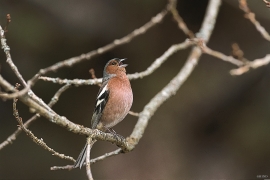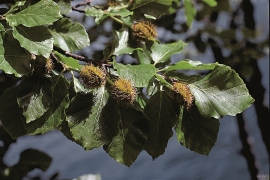Published: 07.08.2015 | Author: Bjørn Moe, Stein Byrkjeland
WORLD'S MOST NORTHERLY BEECH FOREST
On Vollom, northwest of Seim, we find the only natural beech forest in Western Norway, which is also the most northerly of its type in the world. Beech grows also many other places in the county, but these trees are totally lacking in history compared with those of Vollomskogen Forest.
How old is the beech forest at Vollom? This question has been raised by botanists since the time when Mathias Numsen Blytt visited the forest. He thought that the mountainside all the way from Alverstraumen and northward "without doubt already in the oldest historical times had been covered with beech forest stretching for several miles". It was first when professor Knut Fægri was turned loose on the question that the secret of the forest's age was revealed. With the help of pollen analysis, Fægri traced the beech at Seim back to the first thousand years A.D.
Perhaps Chr.A.Wulfsberg was not so far off when he at the end of the 1800s wrote that the beech was imported by a hardy Viking, who either under a loving moon or in order to get a hold of hard wood for ship-building carried a bushel of beech nuts over the North Atlantic and planted them about his longship's boathouse. In any case it is not very likely that beech got established in Lindås on its own accord. For that, the nuts are too heavy and the distance to the nearest natural populations too far. That the tree-type nonetheless has grown and set seed on Vollom for over a thousand years is perhaps related to the existence of a Royal Estate on Seim, right nearby, at the time the beech forest emerged.
The beech forest on Vollom does not have a particularly rich plant assemblage. Blueberry and wavy hairgrass are among the species that manage best. The vegetation is not very diverse because much of the forest floor is covered with a thick layer of fallen leaves. Neither does it help the growing conditions that the forest is quite shady in summertime. The wood anemone avoids this problem since it flowers early in the spring, before the leaves come out on the trees.
The boundary with the beech forest along Lure Fjord. From the fjord, the tree grows just about a kilometre up over the valley. It spreads out in the wilderness, where there are better growing conditions. The forest thrives well there and grows denser now than at any time during the past hundred years. Beech trees can be up to 400 years old. The trees on Vollom are not especially old by these standards. Beech is considered to be a deciduous tree, even though it is not especially demanding with respect to soil type. Its main distribution in Norway today is in Vestfold and the southern part of Telemark.
Birds live close together in the beech forest
72 pairs of birds nest in the beech forest. At least, that was the case in 1973, when the bird population was better studied. The forest is not big, so the documented density that year was 744 pairs per km².
This is unusually high for western Norway. In all, 17 different bird species were observed nesting here. The most common was the Willow Warbler, as is often the case in other forest environments in our part of the country. But, the Redwing was the most numerous, and the Blackbird, Robin and Chaffinch (picture) were also quite common.
In years with good production of beech nuts, large flocks of Bramblings may gather in such forests in winter. We know this from beech forests near Fantoft in Bergen, where many thousands of Bramblings gathered in the winter of 1998/99.
- Fægri, K. 1954. On the origin of the beech forest Fagus sylvatica L. at Lygrefjorden, near Bergen. Danmark Geol. Unders.Række II 80:230–249.
- Holmboe, J. 1908. Bøgeskogen ved Lygrefjord i Nordhordland. Bergen Mus. Årb. 13:3–22.
- Langhelle, G. 1979. Ornitologiske inventeringer på Lindåshalvøya. Lindåsprosjektet, rapport 23.





